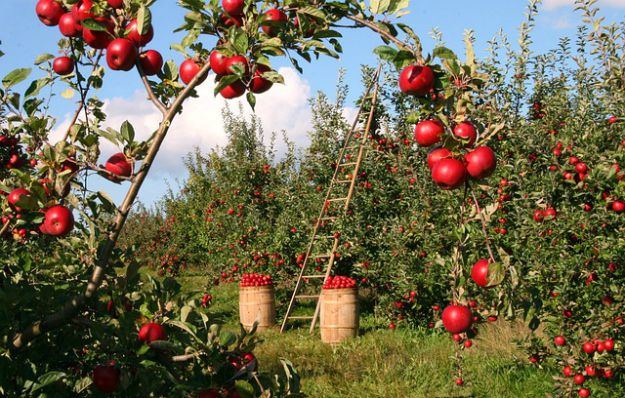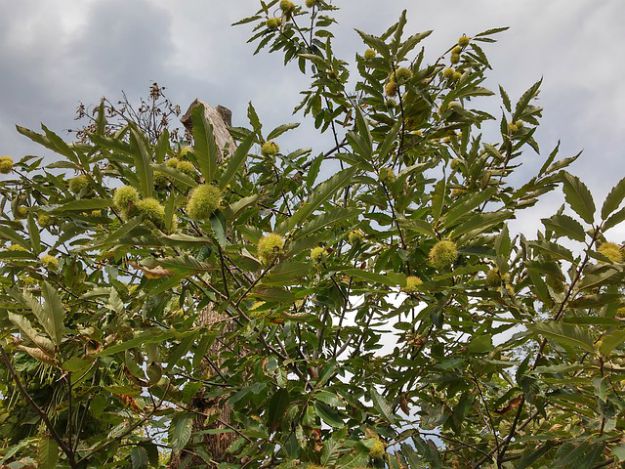Some fruit and nut trees can take anywhere from 1 to 7 years before they begin to produce any fruits and some nuts can take even longer. I think it’s best to purchase a sapling that’s already a few years old from a trusted seller to take a little time off of the waiting, instead of planting them from seeds.
Fruit and Nut Trees: Which Bear Fruit and Nuts the FASTEST?
It can seem like forever before you get your first tiny yield but it’s worth the time and investment in order to have fresh fruit available on your homestead. One must also consider factors like the environment, climate, soil conditions, and growing zones when looking into planting fruit and nut trees. Some trees can be grown in a greenhouse if the environment is right and the greenhouse large enough. There are also several dwarf varieties of trees for those of you with limited space. Imagine little peaches or lemons growing in a pot right on the deck!
Fastest Growing Fruit Trees

- Figs: A fig tree has the potential to bear fruit within 1-4 years but some varieties can take up to 7 years before there’s anything to harvest. Figs grow well unprotected in zones 8-10 but there are some cold-hardy species that can grow in zones 5-10. A fig tree can get to be about 20-feet tall and 20-feet wide. They can be pruned in order to keep them smaller. Most varieties of the fig trees are self-fertile and do not require a pollinator but there is a species in California that is grown specifically for the fig newton snack cookies that do need a pollinator in order to fruit.
- Citrus Trees: Oranges, lemons, limes, and grapefruits all fit this list. There are several varieties of citrus trees that will bear fruit within 1-4 years. They grow in zones seven and up with some cold-hardy varieties available in zone 6. Citrus trees are self-fertile so they do not require a mate for cross-pollination. On average citrus trees can grow 18 to 22-feet and the dwarf varieties reach 8-11.
- Banana: Banana trees only take 3-5 years before they begin bearing fruit. They grow in zones 8 and up while some cold hard varieties can be grown as low as zone 6. Two cold-hardy varieties that do well are the Basjoo and Musa. On average they reach 18-feet tall with the dwarf measuring only 10-feet tall. Some varieties require a pollinator while others are self-fertile.
- Mulberry: Mulberry trees take 3-5 years to fruit. This tree grows well in zones 5-9. The white mulberry tree can reach heights of 80-feet tall and the red mulberry that grows further south can reach up to 70-feet high. That’s the tallest they can grow but typically they can reach 20 to 35-feet tall. There are self-pollinating and trees that require pollinators.
- Olive: Olive trees will begin producing within 3-5 years. They are subtropical so they prefer zones 10 and 11 but some cold-hardy varieties can be grown as low as zone 8. Olive trees require two or more trees in order to cross-pollinate in order to bear fruit. They rarely reach over 15-feet tall.
- Pomegranate: Pomegranates only take 3-5 years before they fruit. They are self-pollinating so you only need one. The cold-hardy varieties can be grown in zones 7 and up. The pomegranate tree can reach about 8-feet tall and there is a dwarf variety that is only 3-4 feet tall.
- Peaches, Nectarines, Apples: All of these trees can begin producing fruits within 3-6 years. They fare well in zones 4-8 but apples really love zones 6 and 7. They can grow 25-35 feet tall but with proper trimming, they can stay smaller than that.
Fruits like sweet cherries, pears, persimmons, and plums can take up to 8 years to fruit if not longer. Of course, as with anything, it is possible that they bear fruit earlier. If you are in search of survival property look for fruit and nut trees because it can take years before you have anything to survive off of.
Fastest Nut Bearing Trees

Just as with the fruit trees, there are varieties of each that are self-pollinating and other varieties that require a pollinator. When it comes to nut trees I think it’s a good idea to plant more than one whether they are self-fertile or not. Nuts can be difficult to grow and already take a while so it’s best to plant more than one.
- Butternut: The butternut is a variety of walnut. It can take anywhere from 3-5 years before they produce any nuts. They grow well in zones 3-7. Butternut trees can reach heights of 40 to 60-feet tall.
- Almonds: An almond tree needs 3-6 years before it bears any nuts. They grow well in zones 5-9 and can reach heights of 13 to over 30-feet tall. Almonds seem to get sweeter the older the tree gets.
- Chestnut & Heartnut: The chestnut tree can take 4-7 years before it produces any nuts and thrives in zones 4-8. The heartnut takes 4-7 years, some varieties can take longer, before they fruit. The heartnut grows in zone 6. A chestnut tree can grow between 80 to 100-feet tall and the heartnut can reach up to 30-feet.
A majority of the other nut trees can take anywhere from 5-12 years before they offer anything to harvest.
Fast Growing Fruit and Nut Trees shows us how to get fruit on the first year:
When it comes to self-sufficiency and self-reliance it’s important to grow your own foods, as much of it as you can at least. It takes patience waiting for fruit and nut trees to bear a decent bounty.
Do you know of any quick to grow fruit trees? Let us know in the comments. Happy Growing!
Want to learn how you can grow your food in your own backyard? Check out helpful tips on how to grow all the food you need in your backyard and start growing your own food today!

Papaya will produce fruits in usually the 1sr or 2nd year. Word of warning though, they are hollow. Grown best in tropical areas such as Central Florida. Can be grown in large pots and brought indoors during cooler weather. Super easy to grow front seed. An added advantage is, once dried, the papaya seed is an excellent alternative or substitute for black pepper.
You share amazing information. I am agreed with you as you think it the best to purchase a sapling instead of planting them from seed. Really the best way to purchase a saplings.